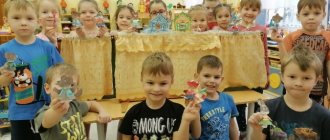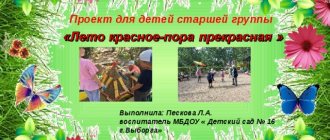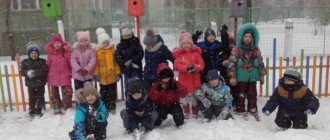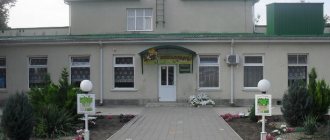CONSTRUCTION PROJECT “We imagine, we create, we design!”
Accessibility and visibility
Integration of developmental training,
Individualization and differentiation of the educational process,
Active development of emotional-aesthetic and moral-evaluative attitude towards reality, nature, psychological comfort and variability.
The principle of phasing, which entails the distribution of activities between all participants in the educational process.
Approaches to project formation:
Personality-oriented:
The pedagogical process has an active and creative nature, which allows, through reliance on systems of interrelated concepts, ideas and methods of action, to ensure and support the processes of self-awareness, self-expression of the child’s personality, and the development of his unique individuality
Individual:
It involves the widespread introduction of new non-traditional forms and methods of education, providing an individual approach to each child, with the aim of developing individuality
Cultural:
Creating conditions for the most complete (taking into account age) acquaintance with the achievements and development of the culture of modern society and the formation of various cognitive interests in folk art and the history of their homeland
Differentiated:
Differentiation in various types and forms is assumed, taking into account individual-typological characteristics of the individual in the form of grouping of students and different construction of the learning process in selected groups.
Activity:
It is based on the concept of “leading activity” existing in psychology. The draft stipulates that the “leading activity” is constructive activity.
Project stages
Preparatory
Questioning parents;
selection, analysis of programs and methodological literature;
selection of materials and equipment for design;
selection of consultations for parents about the importance of design in
development of cognitive and research activities of children;
Basic
Project implementation activities;
GCD, joint activities, observations;
Final
Analysis of project results
Type of construction material:
1. Building material - volumetric (or planar) wood
painted (or unpainted) building parts simple
geometric shape.
2. Paper, sticks.
3. Colored soft and hard volumetric large-sized modules.
4. Different types of constructor.
Project result
The main feature of children's design is the establishment of the spatial arrangement of the elements of an object and its subordination to a certain logic. During the implementation of the project, children name and recognize the details of the LEGO and Baby construction sets, can replace the missing part with a similar one, and are able to create structures from different types of construction sets at their own request; know how to use different means to achieve results (diagrams, models, drawings, samples). The unity of the children's team is observed: the skills of cooperation with a partner have been formed, the pupils are able to solve problems together, distribute roles, explain to each other the importance of this constructive solution, strive to become a participant in a collective role-playing game using crafts from various types of construction sets.
Project "Lego construction and robotics" in the preparatory group
Bibliographic description:
Basanets, L. A. Project “Lego construction and robotics” in the preparatory group / L. A. Basanets, Yu. O. Stepanenko. — Text: direct // Questions of preschool pedagogy. — 2022. — No. 6.1 (23.1). — P. 3-5. — URL: https://moluch.ru/th/1/archive/128/4242/ (access date: 01/29/2022).
Project type: educational and gaming
Project duration: long-term (September - May)
Project participants: preparatory group children, teachers, parents.
Relevance of the project
Construction is one of the most popular and common types of development of fine motor skills, as well as speech, thinking, imagination, attention, memory, and intelligence in children. This project is relevant because it opens up the world of technology and design for older preschoolers. In addition, children become familiar with spatial indicators such as symmetry and asymmetry.
A modern child strives to understand the environment; he is interested in everything unknown, the structure of the world, the past and the future. He asks a lot, reasons, expresses his guesses, thinks and offers his own ways to solve existing problem situations. But not every adult knows and realizes that children play in order to learn to master the objects around them, that is, to acquire skills, knowledge and skills. LEGO building, more than other activities, prepares preschoolers for the ability and development of technical skills. The use of LEGO construction sets is an excellent tool for the intellectual development of preschool children, ensuring the integration of various types of activities. The program is integrated in nature and is based on an activity-based approach to learning. Working with LEGO constructors promotes the development of spatial thinking, since three-dimensional design is much more difficult than laying out any models on a plane. At the same time, the child pays attention not only to the general appearance of the future structure, but also to every detail of it.
Formulation of the problem
Nowadays there is an acute problem of organizing work to intensify cognitive interest in technical creativity and the formation of initial technical skills. When solving this problem, teachers are faced with the lack of necessary special conditions in the institution for the development of design and robotics. Therefore, the need to introduce LEGO construction and robotics into the educational process of kindergarten makes it possible to create favorable conditions for introducing preschoolers to scientific and technical creativity through LEGO construction and robotics and the formation of initial technical skills.
The goal of the project: to introduce preschoolers to children's scientific and technical creativity through LEGO construction and robotics.
Project objectives:
– to develop skills and abilities in LEGO construction, to facilitate the acquisition of initial experience in solving design problems;
– promote the development of cognitive interest in LEGO construction and robotics;
– develop visual perception, logical thinking, working memory, fine motor skills, spatial orientation.
Methods and forms of work:
– accessibility and visibility;
– consistency and systematicity of training and education;
– taking into account the age and individual characteristics of children.
When working with families, the following forms of work are used:
– participation of parents in enriching the subject-development environment;
– familiarizing parents with the meaning and possibilities of Lego construction;
– instilling the traditions of Lego construction in family pedagogy.
Expected results:
Children will learn:
– build positive self-esteem and self-confidence through creating a situation of success in the classroom;
– develop logical thinking and creative abilities;
– enrich the lexical vocabulary of preschoolers, including technical vocabulary;
– develop attention and patience, calmly experience failures and be persistent on the path to the goal.
Event schedule:
| date | weeks | Work with children | Working with parents | Improving the subject-development environment |
| September | 1. | D/game “Colorful trailers” D/exercise "Find by touch" | Parent meeting “Introduction to Lego Design” | Making children's robots from Lego constructors |
| 2. | D/exercise "Wonderful bag" D/game “Colored lanterns” | |||
| 3 | D/exercise "What changed?" D/game “Yes-no” | |||
| 4 | D/game “On the contrary” D/exercise “Collecting and counting” | |||
| October | 1 | D/game “Colored rugs” D/exercise "Make a whole from parts" | ||
| 2 | D/exercise "Traffic light" D/game “Name and Build” | |||
| 3 | D/exercise "Lego gifts" D/game “Don’t take the last die” | |||
| 4 | D/game “Merry little engine” D/exercise "Remember the location" | |||
| November | 1 | D/game “Fish, Beast, Bird” D/exercise “Assemble the model from memory” | Consultation “Involving children in children's scientific and technical creativity” | Enriching the subject-development environment with the help of parents. |
| 2 | D/exercise "Post the other half" D/game “Our wonderful plane” | |||
| 3 | D/exercise "Make a pattern" D/game “Let’s build turrets” | |||
| 4 | D/game “Select similar” D/exercise "Tic Tac Toe" | |||
| December | 1 | D/game “Make no mistake Parsley!” D/exercise "Colorful Mugs" | ||
| 2 | D/exercise "Guess it" D/game “Assemble the Christmas tree” | |||
| 3 | D/exercise "Lego - gifts" D/game “Animals in the forest” | |||
| 4 | D/game “What has changed?” D/exercise “Name it and tell it to me” | |||
| January | 2 | D/exercise "On the contrary" D/game “Find out and compare” | Folder for parents “Design and robotics” | |
| 3 | D/exercise "Remember the location" D/game “What’s extra?” | |||
| 4 | D/game “Collect the picture” D/exercise "Make a pattern" | |||
| February | 1 | D/game “Beast, fish, bird” D/exercise "Build a Snowman" | ||
| 2 | D/exercise "Select similar" D/game “Wonderful bag” | |||
| 3 | D/exercise "Lay out your other half" D/game "Houses" | |||
| 4 | D/game “Assemble a car” D/exercise "Lanterns" | |||
| March | 1 | D/game “Remember the location” D/exercise “What color is missing?” | Open lesson for parents “Assemble a pattern” | Preparation of didactic material for open classes |
| 2 | Modeling “Assemble a rug from colored pieces” D/game “Tic Tac Toe” | |||
| 3 | D/exercise "Collect a flower" D/game “Assemble a model from memory” | |||
| 4 | D/game “Labyrinths” D/exercise “Collecting and counting” | |||
| April | 1 | D/game “Don’t take the last die” D/exercise "Multi-colored stream" | ||
| 2 | D/exercise "Spring flowers" D/game “Find the same one” | |||
| 3 | D. control "Sun" D/game “Pick up the rays” | |||
| 4 | D/game “Lay out according to the model” D/exercise "Guess it" | |||
| May | 1 | D/game "Merry caterpillar" D/exercise "Make a pattern" | Creative competition among parents “Make it with your child” (Making an educational game with your own hands) | Designate an area for the material used to develop initial technical skills |
| 2 | D/exercise "Colored rugs" D/game “Big, medium, small” | |||
| 3 | D/exercise "Collect a butterfly" D/game “Fold the Rainbow” | |||
| 4 | D/game “Assemble a house” D/exercise “Lay out the figures from memory” |
Key terms
(automatically generated)
: game, LEGO, logical thinking, fine motor skills, skill, cognitive interest, the last brick, subject-development environment, involvement of preschoolers, work.
Lego project on traffic rules for children of the preparatory group
Lego project in kindergarten “On the way to kindergarten.”
Preparatory group Author of the article:
Elena Nikolaevna Averyanova, teacher at the Children's Educational Institution No. 2 of the kindergarten “Happy Childhood” in the city of Sovetsk, Kaliningrad region.
The material is useful for reviewing educators and parents. Goal:
- To develop in children the skill of competent behavior on the road, to develop an understanding of the cause-and-effect relationships of the occurrence of dangerous situations.
Objectives:
- Expand and consolidate knowledge about traffic rules.
— To develop in children a sense of responsibility for their behavior on the road. — Apply modern forms and methods of education and training of preschool children, innovative technologies aimed at preventing accidents on the streets and roads of the city. — To form a sustainable interest in modeling using Lego constructors. Relevance of the project:
This problem has become particularly acute in the last decade, due to the growing disproportion between the increase in the number of cars and the extremely weak safety culture and discipline of road users.
Increasing traffic density makes roads increasingly dangerous for children and, accordingly, the issues of preventing children's road traffic injuries do not lose their relevance. The relevance of the problem at the social level is due to the need of modern society to educate competent pedestrians who are ready to follow traffic rules and take care of their health and the health of other people. On the way to our kindergarten, pupils often have to cross more than one street. Knowing and following the basic rules of safe behavior on the streets and roads will help protect them from accidents and save their lives. Therefore, the topic of our project is extremely important and relevant. This project aims not only to teach children the rules of the road, but also at the same time to form in preschoolers respect for them and an understanding of the need to comply with them. Methods and techniques used during the project:
Visualization method (viewing illustrations, albums, viewing thematic presentations).
Problem-motivational method (stimulates children’s activity by including a problem situation). Verbal method (conversation, artistic expression, explanations). Practical method (children do the work independently, use various diagrams and drawings). Heuristic method (development of resourcefulness and activity). Co-creation (interaction between teacher and child in a single creative process). An effective way to teach safe behavior skills is to model game-based learning situations, which contain in their structure a triad of components that provide valuable pedagogical properties: game, imitation and analysis of a specific situation. Project duration:
1 month.
Project participants:
- children;
-educator; -parents. Project stages:
1. Preparatory stage.
2. Main stage. Construction stage. 3. Final stage. Expected result:
— The project contributes to solving the important problem of road safety, fosters individual responsibility among project participants, and increases the interest of preschoolers in the process of research activities.
Preparatory stage.
During educational classes on “Fundamentals of Life Safety” we studied the ABCs of a competent transition. The study of this science took the form of considering specific road situations that preschoolers encounter every day; the rules of safe movement on the streets and roads were repeated and reinforced in a playful manner.
Using visual aids, the children learned how dangerous situations arise on the road and what or who causes them.
When studying the rules of the road, more attention was paid to becoming familiar with different road signs.
During design classes, they made them out of colored paper and used computer disks, and then explained what each symbol meant.
Work on developing the basics of safety among preschoolers was carried out in close contact with the parents of the pupils. They helped in the selection of materials in all areas of work, produced visual aids “More respect for traffic rules”, “Poems about road signs”, “Dangerous situations on the roads”.
Main stage.
Construction stage. The most interesting stage of working on the project was LEGO - construction. During the afternoon classes, we decided to use Lego to consolidate our knowledge of traffic rules and learn to use the acquired knowledge in everyday life. The children's work began with the construction of our kindergarten.
Then the children began to install the road that runs next to the institution.
Then the guys “built” houses in the adjacent microdistrict.
Crossroads were modeled on the plateau.
We tried to place the necessary road signs on the roads.
On their own behalf, the children added traffic lights that they would like to see more often on our roads.
The Alley of Heroes in front of the kindergarten also deserves attention: there are both pedestrians and cyclists.
All road users must know the rules of movement!
The final stage.
Having well mastered the ABCs of safe behavior on the streets and roads, our students taught others how to behave at pedestrian crossings, what is allowed and what absolutely cannot be done.
Project results.
— Pupils have developed skills of competent behavior on the road. — The children consolidated their skills in working with Lego constructors. They can work according to diagrams, drawings, conditions. They can make decisions independently and plan their actions. Children are able to work in groups, doing collective work. — During the project, the parents of the students took an active part in preparations for the Lego festival. They selected the material and enriched the developmental environment in accordance with the planned activities. — Participation of children in the municipal Lego festival among educational institutions.
We recommend watching:
Leisure summary according to traffic rules. Middle group Summary of educational activities to familiarize children with traffic rules in the senior group Summary of an integrated lesson on traffic rules in the preparatory group Summary of the educational situation on light engineering in the senior group of preschool educational institutions
Similar articles:
Scenario of a children's summer holiday on traffic rules in the 1st junior group with parents
Scenario of a morning performance on traffic rules in the preparatory group





